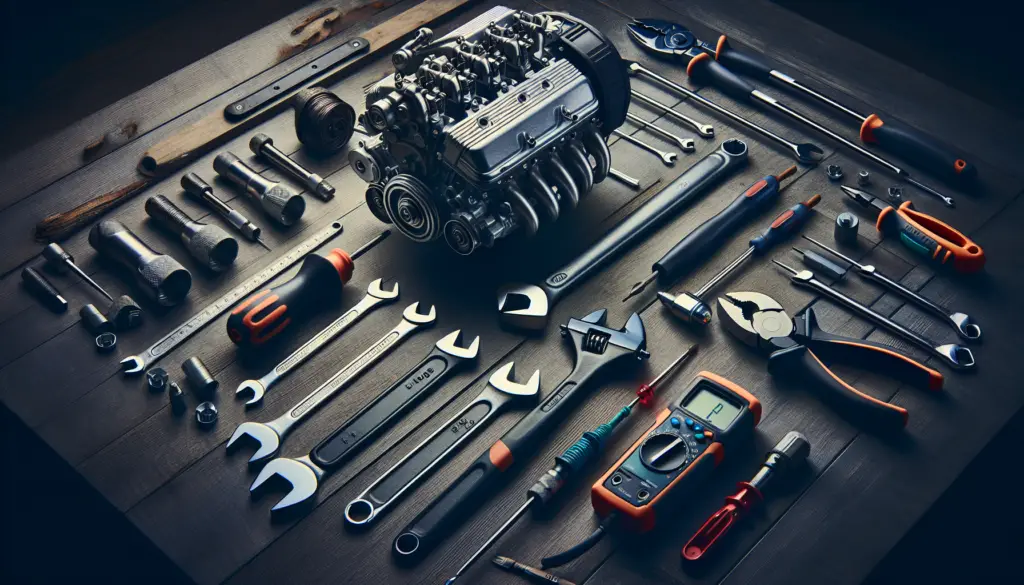Are you a boat enthusiast looking to take your boat engine customization to the next level? Look no further! In this article, we will unveil the top 5 tools that are essential for achieving the perfect customized boat engine. From high-quality wrench sets to advanced diagnostics systems, these tools are guaranteed to make your customization process a breeze. So, grab your toolbox and get ready to explore the world of boat engine customization!
1. Fuel Injector Cleaning Kits
1.1 Why is it important?
Proper maintenance of your boat’s fuel injectors is crucial for the performance and longevity of your engine. Over time, fuel injectors can become clogged with deposits and impurities, which can lead to poor fuel atomization and inefficient combustion. This can result in reduced power, decreased fuel efficiency, and even engine misfires. By using a fuel injector cleaning kit regularly, you can effectively remove these deposits and restore your injectors to their optimal condition, ensuring smooth and efficient fuel delivery.
1.2 How does it work?
A fuel injector cleaning kit typically consists of a cleaning solution and a delivery system. The cleaning solution is designed to break down and dissolve the deposits that have accumulated on the injectors. The delivery system allows you to introduce the cleaning solution directly into the fuel system, either through the fuel rail or the intake system. Once the cleaning solution reaches the injectors, it works to dislodge and remove the deposits, restoring the injectors’ performance. Some kits also include attachments for performing additional maintenance tasks, such as cleaning the throttle body or intake valves.
1.3 Top products in the market
BG 44K Fuel System Cleaner: This popular fuel injector cleaning kit is highly regarded for its effectiveness in removing deposits and restoring fuel system performance. It is compatible with gasoline, ethanol-blend, and diesel fuels.
Chevron Techron Concentrate Plus: This fuel system cleaner is trusted by many boaters for its ability to clean fuel injectors and other fuel system components. It can help improve fuel economy and reduce emissions.
Sea Foam SF-16 Motor Treatment: While not specifically marketed as a fuel injector cleaner, Sea Foam is a versatile product that can effectively clean fuel injectors, carburetors, and other engine components. It is a popular choice among boaters for its ability to remove varnish and gum deposits.
Lucas Oil Deep Clean Fuel System Cleaner: This fuel system cleaner is formulated to deep-clean injectors and improve fuel system performance. It has been known to resolve rough idle, hesitation, and other fuel-related issues.
Red Line Complete SI-1 Fuel System Cleaner: Red Line’s fuel system cleaner is designed to clean fuel injectors, intake valves, and combustion chambers. It can help improve fuel efficiency, reduce emissions, and restore lost power.
2. Engine Tuning Software
2.1 What is engine tuning?
engine tuning refers to the process of optimizing an engine’s performance by adjusting various parameters to achieve the desired balance between power, fuel efficiency, and reliability. This process usually involves modifying the engine management system’s settings, such as fuel injection timing, ignition timing, and air-fuel ratio, to achieve the desired performance characteristics.
2.2 Benefits of engine tuning
Engine tuning can offer several benefits for boat owners looking to get the most out of their engines. By optimizing the engine’s performance, you can potentially increase power output, improve fuel efficiency, and enhance throttle response. Tuning can also address specific performance issues, such as reducing turbo lag or improving low-end torque. Additionally, engine tuning can be used to accommodate modifications or aftermarket components, ensuring the engine operates optimally with these additions.
2.3 Popular engine tuning software
MEFIpro: MEFIpro is a popular engine tuning software that is specifically designed for marine applications. It allows users to modify various engine parameters, such as fueling, ignition timing, and boost control, to optimize performance. MEFIpro supports a wide range of MEFI ECMs commonly used in boat engines.
HP Tuners: HP Tuners is a versatile tuning software that supports a wide range of vehicle applications, including marine engines. With HP Tuners, users can tune various engine parameters and customize their engine’s performance to their specific needs.
AEM Infinity Tuning Software: AEM Infinity Tuning Software is a comprehensive tuning solution designed for high-performance engines, including marine applications. It offers advanced features and customization options to fine-tune engine performance.
SCT Performance Advantage III: SCT Performance Advantage III is a popular tuning software used in various automotive applications, including marine engines. It provides users with the ability to modify fuel, ignition, and other engine parameters to optimize performance.
Diablosport Predator: Diablosport Predator is a handheld tuner that allows users to modify engine parameters on the go. It offers preloaded tunes for popular boat engines and is known for its user-friendly interface.
3. Propeller Pitch Gauge
3.1 Understanding propeller pitch
The pitch of a propeller refers to the distance the propeller would move in one revolution if it were moving through a solid. It is typically measured in inches and represents the theoretical forward distance covered by the propeller in each revolution. A higher pitch propeller will result in more forward distance covered per revolution, while a lower pitch propeller will provide more pulling power.
3.2 Importance of proper pitch
Using the proper propeller pitch is crucial for optimizing your boat’s performance. A propeller with an incorrect pitch can result in inefficient fuel consumption, decreased top speed, and poor acceleration. If the pitch is too high, the engine may struggle to reach the desired RPM range, leading to sluggish performance. On the other hand, a propeller with a pitch that is too low may cause the engine to over-rev, potentially damaging the engine and compromising efficiency.
3.3 Top propeller pitch gauges
Solas Propeller Pitch Gauge: This pitch gauge is widely used by boaters for accurately measuring the pitch of their propellers. It features a simple yet effective design and is compatible with various propeller sizes.
Quicksilver Propeller Pitch Gauge: Quicksilver offers a reliable pitch gauge that ensures accurate measurement of propeller pitch. It is designed to provide boaters with a quick and easy way to determine the correct pitch for their propellers.
T-H Marine PropTool Propeller Pitch Gauge: This pitch gauge combines accuracy and durability in one compact tool. It is designed to fit a wide range of propellers and features an easy-to-read scale for precise measurement.
Shoreline Marine Propeller Pitch Gauge: This affordable pitch gauge offers reliable performance for measuring propeller pitch. It features a user-friendly design and is suitable for both experienced boaters and beginners.
Attwood Propeller Pitch Gauge: Attwood’s pitch gauge is a versatile tool that can be used to measure the pitch of various propeller sizes. It is designed to provide accurate readings and assist boaters in finding the optimal propeller pitch for their specific needs.

4. Compression Tester
4.1 Why test engine compression?
Testing engine compression is an essential part of engine maintenance and troubleshooting. Engine compression refers to the pressure created within the engine’s combustion chamber during the compression stroke. It is a measure of the engine’s mechanical integrity and efficiency. By testing engine compression, you can identify any potential issues, such as worn piston rings, leaking valves, or a blown head gasket, which can affect engine performance and reliability.
4.2 How to use a compression tester
Using a compression tester is a straightforward process that allows you to measure the compression pressure in each cylinder of your boat’s engine. Here’s a step-by-step guide on how to use a compression tester:
Start by shutting off the engine and removing the ignition coil wire to prevent the engine from starting during the test.
Remove the spark plug from the cylinder you want to test and screw the compression tester’s threaded end into the spark plug hole.
Make sure the compression tester’s gauge is visible and in a convenient location for reading.
Have someone crank the engine over using the starter motor for several seconds, while you observe the pressure reading on the compression tester’s gauge.
Repeat this process for each cylinder, recording the compression pressure for each one.
Compare the compression readings for each cylinder to the manufacturer’s specifications to determine if any cylinders are experiencing low compression.
4.3 Recommended compression testers
OTC 5606 Compression Tester Kit: This comprehensive kit includes everything you need to accurately test engine compression. It features a durable gauge with a large, easy-to-read display and comes with multiple adapters to fit various spark plug sizes.
Innova 3612 Compression Tester: Innova’s compression tester is a reliable tool for testing engine compression. It features a rugged design, an easy-to-read gauge, and a long hose for added convenience.
Actron CP7827 Compression Tester: Actron offers a quality compression tester that provides accurate readings. It includes a standard 14mm threaded tip and comes with a carrying case for easy storage and transportation.
Craftsman Compression Tester: Craftsman’s compression tester is a versatile tool suitable for a wide range of engines. It features a durable construction and an easy-to-read gauge for hassle-free testing.
Astro Pneumatic Tool 78568 Compression Tester Kit: This compression tester kit includes a precision-made gauge and multiple adapters, making it compatible with most spark plug sizes. It is designed for professional use and provides accurate compression readings.
5. Ignition Timing Light
5.1 What is ignition timing?
Ignition timing refers to the precise moment at which the spark plug fires in the combustion chamber during the engine’s power stroke. It plays a crucial role in determining the engine’s performance, fuel efficiency, and overall reliability. Proper ignition timing ensures efficient combustion and maximizes power output while minimizing the risk of engine damage.
5.2 Why is it important to adjust timing?
Adjusting ignition timing is important for several reasons. Firstly, it allows you to optimize the engine’s power output and performance. By advancing or retarding the ignition timing, you can fine-tune the engine to achieve the best balance between power and fuel efficiency. Additionally, adjusting timing can help address specific issues such as engine knock or detonation, which can occur when the combustion process is not properly timed. Ignition timing that is too advanced or too retarded can lead to decreased performance, increased fuel consumption, and potential engine damage.
5.3 Top ignition timing lights
Actron CP7527 Inductive Timing Light: This timing light offers a bright xenon bulb for easy visibility, even in daylight. It features a built-in advance dial and comes with a comprehensive user manual to assist with timing adjustments.
Innova 3551 Inductive Timing Light: Innova’s timing light is a versatile and user-friendly tool for adjusting ignition timing. It features an easy-to-read digital display, an advanced dial, and detachable leads for convenience.
Craftsman Adjustable Ignition Timing Light: Craftsman offers a reliable timing light suitable for both beginners and experienced users. It features a bright xenon bulb, a built-in dial for advance adjustment, and a durable construction.
Performance Tool W80578 Advance Timing Light: This timing light is designed for accurate timing adjustments. It features an inductive pickup, a high-intensity xenon bulb, and detachable leads for ease of use.
Equus 5568 Pro Timing Light: Equus’ timing light is a professional-grade tool that provides accurate timing adjustments. It features a xenon bulb, an ergonomic design, and a built-in advance feature to fine-tune the timing.

6. Diagnostic Code Readers
6.1 What are diagnostic code readers?
Diagnostic code readers, also known as scan tools or code scanners, are devices used to access and interpret the diagnostic trouble codes (DTCs) stored in a vehicle’s onboard computer system. These codes are generated when the computer system detects a fault or malfunction in one or more of the vehicle’s systems. Diagnostic code readers allow users to retrieve these codes, which can provide valuable information for diagnosing and troubleshooting engine or system issues.
6.2 Benefits of using code readers
Using a diagnostic code reader offers several benefits for boaters, including:
- Quick and accurate diagnostics: Code readers allow boaters to quickly retrieve and interpret DTCs, providing valuable insight into potential engine or system issues.
- Cost savings: By identifying the root cause of a problem using a code reader, boaters can avoid unnecessary parts replacements or labor costs associated with inaccurate diagnoses.
- Enhanced efficiency: Code readers can streamline the troubleshooting process by providing a clear direction for repairs, reducing downtime and getting boaters back on the water faster.
- Information access: Some code readers offer additional features, such as live data streaming, which allows users to monitor engine parameters and performance in real-time.
6.3 Best diagnostic code readers
BlueDriver Bluetooth Professional OBDII Scan Tool: This wireless scan tool connects to your smartphone or tablet via Bluetooth, providing a user-friendly interface and comprehensive diagnostics. It supports all OBDII protocols and offers advanced features, including live data streaming and mode 6 capability.
ANCEL AD310 Classic Enhanced Universal OBDII Scanner: The ANCEL AD310 is a budget-friendly yet reliable code reader. It features a large LCD screen, supports all OBDII protocols, and offers basic diagnostics for engine, transmission, and emission systems.
Autel AutoLink AL319 OBD2 Scanner: The AutoLink AL319 is a versatile code reader suitable for both beginners and experienced boaters. It features a color-coded LED display for easy interpretation of codes, supports all OBDII protocols, and offers basic diagnostic functions.
Launch X431 Creader VII+ ABS/SRS Transmission Diagnostic Scan Tool: The Launch X431 Creader VII+ is a comprehensive scan tool that provides access to ABS, SRS, and transmission system diagnostics in addition to basic OBDII functions. It features a large color display, supports live data streaming, and offers advanced diagnostic capabilities.
FOXWELL NT301 OBD2 Scanner: The FOXWELL NT301 is a popular choice among boaters for its user-friendly interface and wide vehicle compatibility. It supports all OBDII protocols, offers basic diagnostic functions, and features a large color display for easy code reading.
7. Torque Wrench
7.1 Importance of proper torque
Using the proper torque when tightening fasteners is essential for ensuring the structural integrity and performance of your boat’s engine. Under-tightened fasteners can lead to loose components, increased wear, and potential safety hazards. On the other hand, over-tightened fasteners can cause damage to the fastener threads, the mating parts, or the gasket seals. Using a torque wrench allows you to apply the correct amount of torque to fasteners, ensuring proper clamping force and preventing costly damage.
7.2 How to use a torque wrench
Using a torque wrench correctly is crucial for accurate torque application. Here are the steps to use a torque wrench:
Select the appropriate torque value for the specific fastener you are tightening. Consult the manufacturer’s specifications or service manual for the recommended torque value.
Set the torque wrench to the desired value by adjusting the torque scale or the wrench’s handle.
Attach the proper socket or bit to the torque wrench, ensuring a secure fit.
Position the wrench over the fastener to be tightened and apply steady downward pressure until the wrench clicks or signals that the desired torque has been reached.
Double-check the torque setting and ensure that the fastener is tightened to the recommended value.
Repeat the process for all applicable fasteners, following the proper torque sequence if specified.
7.3 Top torque wrenches for boat engines
Tekton 24335 1/2-Inch Drive Click Torque Wrench: This affordable torque wrench features a reversible ratchet head and a high-contrast dual-range scale for easy torque adjustment. It has a 1/2-inch drive and offers torque settings ranging from 10 to 150 ft-lb.
CDI 2503MFRPH 1/2-Inch Drive Adjustable Micrometer Torque Wrench: CDI’s torque wrench is a professional-grade tool known for its accuracy and durability. It features an adjustable micrometer head for precise torque settings and a 1/2-inch drive. It offers torque settings ranging from 30 to 250 ft-lb.
Craftsman 9-31425 3/8-Inch Drive MicroTork Torque Wrench: This compact torque wrench offers a 3/8-inch drive and a durable alloy steel construction. It features an easy-to-read scale and offers torque settings ranging from 10 to 75 ft-lb. It is a reliable choice for smaller fasteners common in boat engines.
GearWrench 85066 3/4-Inch Electronic Torque Wrench: GearWrench’s electronic torque wrench offers precise torque readings and a user-friendly interface. It features a large digital display, a 3/4-inch drive, and torque settings ranging from 150 to 700 ft-lb.
Snap-on Industrial Brands QD2FR75A 3/8-Inch Drive Quick-Set Fixed Head Torque Wrench: This fixed head torque wrench features a compact design and a 3/8-inch drive. It offers a quick-set torque knob for rapid torque adjustment and provides torque settings ranging from 20 to 100 ft-lb. It is a reliable and durable option for boat engine maintenance.

8. Outboard Motor Height Gauge
8.1 What is motor height?
Motor height, also known as motor setback, refers to the vertical positioning of an outboard motor on a boat’s transom. It determines the depth at which the motor’s propeller operates in the water. Proper motor height is crucial for optimizing boat performance, especially at high speeds.
8.2 Why is motor height crucial?
The correct motor height is important for achieving the optimal balance between boat performance and efficiency. Setting the outboard motor at the correct height ensures that the propeller operates at the right depth in the water, minimizing drag and maximizing thrust. Proper motor height also helps prevent cavitation (the formation of air bubbles around the propeller) and improves overall handling and stability.
8.3 Recommended outboard motor height gauges
Panther 55-0107 Motor Lift Gauge: This motor height gauge features a sleek design and a clear scale for easy measurement. It can be easily attached to the outboard motor and provides accurate height reading to help achieve the desired motor setback.
Davis Instruments Motor Caddy Outboard Hoist & Height Gauge: Davis Instruments offers a motor caddy that doubles as a motor height gauge. It allows for precise motor height adjustment while providing a secure hoisting mechanism for outboard motor maintenance.
T-H Marine MK1DP Outboard Motor Support: The MK1DP provides not only motor support but also a simple and effective motor height gauge. It features a large, easy-to-read scale and offers adjustable height settings to accommodate different boat designs.
SeaSense ID Outboard Motor Support: SeaSense’s outboard motor support doubles as a motor height gauge and provides reliable support and height measurement in one device. It is easy to install and offers accurate height readings for optimal motor positioning.
Oceansouth Outboard Motor Support Bracket: The Oceansouth support bracket offers adjustable height settings for motor support and features a built-in motor height gauge. It is designed for easy installation and accurate motor height adjustment.
9. Air-to-Fuel Ratio Meters
9.1 Understanding air-to-fuel ratio
The air-to-fuel ratio (AFR) is the ratio of the mass of air to the mass of fuel in the combustion chamber of an engine. It plays a crucial role in engine performance, fuel efficiency, and emissions. A stoichiometric AFR of around 14.7:1 (air to fuel) is generally regarded as ideal for gasoline engines, although specific engine designs or modifications may require different AFR targets.
9.2 Benefits of monitoring ratio
Monitoring the air-to-fuel ratio can provide valuable insight into engine performance and fuel efficiency. A proper AFR ensures efficient combustion and optimal power output. By monitoring the ratio, boaters can identify potential issues such as running too rich (excess fuel) or running too lean (excess air), allowing for adjustments to prevent engine damage and maximize performance.
9.3 Top air-to-fuel ratio meters
Innovate Motorsports 3844 MTX-L Plus Wideband Air/Fuel Ratio Gauge: This wideband AFR gauge is highly regarded for its accuracy and reliability. It features a digital display, user-friendly interface, and programmable outputs for data logging or integration with engine management systems.
AEM 30-4110 UEGO Air/Fuel Ratio Gauge: AEM’s UEGO gauge is a popular choice among boaters for monitoring AFR. It offers a large digital readout, a wideband oxygen sensor, and user-configurable peak and hold features for accurate AFR measurement.
PLX Devices DM-6 Air/Fuel Ratio and OBDII Module: The PLX Devices DM-6 offers both air/fuel ratio monitoring and OBDII data logging capabilities. It features a color OLED display, programmable warning lights, and compatibility with various fuel types.
AutoMeter 3378 Sport-Comp Wideband Air/Fuel Ratio Gauge: AutoMeter’s wideband gauge is known for its durability and performance. It features a precise stepper motor, a high-contrast digital display, and a programmable peak recall function.
Prosport Wideband Air Fuel Ratio Gauge: Prosport’s wideband gauge offers accurate AFR measurement at an affordable price. It features a digital display, multiple user-selectable colors, and compatibility with various fuels.

10. Borescope
10.1 How does a borescope help in customization?
A borescope is a tool that allows you to visually inspect and analyze the internal components of an engine without disassembling it. It consists of a flexible tube with a camera on one end and a display or viewing device on the other end. By inserting the borescope into the engine’s cylinders, you can inspect critical components such as the piston heads, valves, and combustion chambers. This enables you to identify any signs of wear, damage, or buildup and make informed decisions regarding customization or maintenance.
10.2 Features to consider in a borescope
When choosing a borescope for engine customization, there are several features to consider:
- Flexible tube length: Ensure that the borescope has a sufficient tube length to reach the desired areas within the engine.
- Camera resolution: Higher camera resolution allows for clearer and more detailed visual inspection.
- Adjustable lighting: Look for a borescope with adjustable LED lighting to provide optimal illumination in different engine environments.
- Display or viewing device: Consider whether you prefer a built-in display or if you would prefer to use your smartphone or tablet as the viewing device.
- Waterproof and durable construction: Engine environments can be harsh, so choose a borescope with a rugged and waterproof design to withstand potential exposure to fluids and dirt.
10.3 Popular borescopes for boat engines
DEPSTECH Wireless Endoscope: This wireless borescope offers a flexible tube and adjustable LED lighting for versatile engine inspection. It features a built-in Wi-Fi module, allowing you to view real-time images directly on your smartphone or tablet.
BlueFire Semi-Rigid Flexible Wireless Endoscope: BlueFire’s wireless endoscope is designed for engine inspection and customization. It features a flexible tube, adjustable LED lighting, and a built-in Wi-Fi module for easy image viewing on your smartphone or tablet.
Teslong Dual Lens Inspection Camera: Teslong’s inspection camera offers a dual-lens design, allowing you to switch between wide-angle and close-up views. It features adjustable LED lighting, a generous tube length, and a built-in rechargeable battery for convenient use.
RIDGID Micro CA-25 Inspection Camera: The RIDGID Micro CA-25 is a handheld inspection camera that offers a compact design and a durable construction. It features a color LCD display, adjustable LED lighting, and a built-in microphone for video recording.
DEWALT DCT412S1 12-Volt Li-Ion 5.8mm Inspection Camera Kit: The DEWALT DCT412S1 is a comprehensive inspection camera kit designed for professional use. It features a detachable wireless screen, a durable and waterproof camera head, and adjustable LED lighting for optimal image quality.

